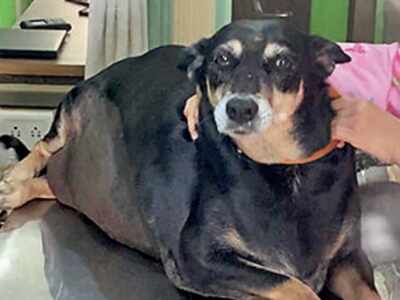Top Searches
- News
- India News
- In rare surgery, doctors staple 50kg dog’s tummy
In rare surgery, doctors staple 50kg dog’s tummy

The dog’s stomach was stapled in a two-hour-long procedure after which it has lost 5kg.
About three years ago, Yasmin Daruwala, started noticing that her otherwise active dog, Deepika, had suddenly grown lethargic, would keep panting and ate more. At 50 kg, Deepika was 30kg beyond what she should have weighed. After considering and ruling out a number of weight-loss diets, doctors decided to perform sleeve gastrectomy, a type of bariatric surgery, on her.
“Stapling of the stomach in a dog was perhaps done by us for the first time in India,” said Dr Narendra Pardeshi, Deepika's vet. For three years, Pardeshi had tried many weightloss diets, but none worked. Operating on her was risky because of her multiple health problems. But it seemed like the only option. So, Pardeshi started training himself for the surgery. He got in touch with Dr Shashank Shah, a noted bariatric surgeon in Pune, and further trained under him for six months. In fact, Shah assisted Pardeshi in Deepika’s surgery.
One-third of the pet's stomach was successfully stapled in a two-hour-long procedure in Pune on June 6. Deepika has lost 5kg and is now slowly going back to her sprightly self.
“It used to be worrying. She would just sit on the couch, salivating and panting. Her food intake went up. I had to spend Rs 10,000 a month on her. That’s when we got in touch with the clinic,” said Daruwala. The surgery cost her a little over Rs 1 lakh.
Pardeshi said hypothyroidism and a high-carb diet had led to a cascading set of health problems. “She had high blood pressure, an enlarged heart, joint problems and a bluish tongue, which meant she was not getting enough oxygen. She had high BMI and would be panting and salivating. For a dog her size, a healthy basal metabolic rate should be 80-90. Hers was 280-290,” he added.
It was a laparoscopic procedure and was done by making three holes on her abdomen. Doctors stapled a portion of her stomach, which should bring down the secretion of hunger hormones by 70%, resulting in gradual weight loss. In another three weeks, she will undergo one more surgery to remove a hernia from a hind leg, which developed because of her weight. For the first week after the surgery, she was fed a liquid diet of chicken soup.
“From today, she will be given wet jelly dog food,” Pardeshi said. Eventually, she will be able to go back to a normal canine diet.
“Stapling of the stomach in a dog was perhaps done by us for the first time in India,” said Dr Narendra Pardeshi, Deepika's vet. For three years, Pardeshi had tried many weightloss diets, but none worked. Operating on her was risky because of her multiple health problems. But it seemed like the only option. So, Pardeshi started training himself for the surgery. He got in touch with Dr Shashank Shah, a noted bariatric surgeon in Pune, and further trained under him for six months. In fact, Shah assisted Pardeshi in Deepika’s surgery.
One-third of the pet's stomach was successfully stapled in a two-hour-long procedure in Pune on June 6. Deepika has lost 5kg and is now slowly going back to her sprightly self.
“It used to be worrying. She would just sit on the couch, salivating and panting. Her food intake went up. I had to spend Rs 10,000 a month on her. That’s when we got in touch with the clinic,” said Daruwala. The surgery cost her a little over Rs 1 lakh.
Pardeshi said hypothyroidism and a high-carb diet had led to a cascading set of health problems. “She had high blood pressure, an enlarged heart, joint problems and a bluish tongue, which meant she was not getting enough oxygen. She had high BMI and would be panting and salivating. For a dog her size, a healthy basal metabolic rate should be 80-90. Hers was 280-290,” he added.
It was a laparoscopic procedure and was done by making three holes on her abdomen. Doctors stapled a portion of her stomach, which should bring down the secretion of hunger hormones by 70%, resulting in gradual weight loss. In another three weeks, she will undergo one more surgery to remove a hernia from a hind leg, which developed because of her weight. For the first week after the surgery, she was fed a liquid diet of chicken soup.
“From today, she will be given wet jelly dog food,” Pardeshi said. Eventually, she will be able to go back to a normal canine diet.
FacebookTwitterLinkedinEMail
Start a Conversation
end of article
Quick Links
Coronavirus in MumbaiFarm bill 2020Farmers protestCoronavirus in DelhiCoronavirus in BangaloreCoronavirus symptomsCoronavirus in IndiaWest Bengal elections 2021Coronavirus NewsSolar EclipseNPRWhat is NRCCAB BillCAB and NRCAssam election 2021Podcast newsLok SabhaTamil Nadu Election 2021CongressBJP newsKerala Elections 2021Indian ArmyISRO newsSupreme Court
